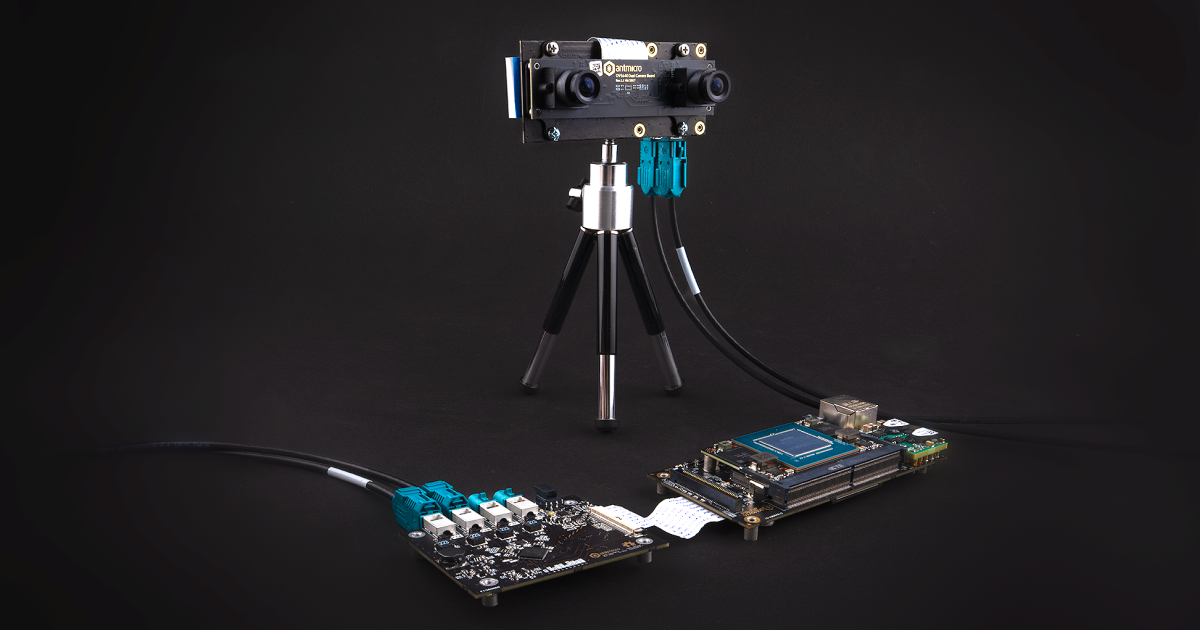Complete GMSL-based solutions for automotive and robotic applications
Published:
Topics: Open hardware, Open machine vision
Analog Devices’ Gigabit Multimedia Serial Link (GMSL) provides high-speed data transmission and long-range coverage with low EMI, making it a great choice for video streaming in harsh environments. Originally, it was developed for automotive applications where it’s used for video transmission within infotainment and driver-assistance systems. However, the GMSL technology is also used in industrial and robotics applications such as obstacle awareness or inspection, and can provide robust video data input to customizable embedded processing platforms such as Antmicro’s Open Source Jetson Orin Baseboard.
Last year we introduced Antmicro’s open source GMSL video streaming hardware which serves as a starting point for rapid prototyping in video system development. Following up on this work, in this article we present a complete setup built with open source components: Antmicro’s GMSL Deserializer featuring Analog Devices MAX96724 and Serializer featuring Analog Devices MAX96717 with the Jetson Orin Baseboard and the OV5640 Dual Camera Board. This reference setup can serve as an example starting point for the type of product we often help our customers build, providing commercial engineering and customization services. You can view and explore a variant of the setup in the System Designer portal, which we use as the backbone of our hardware and software artifact tracking methodology.
Antmicro’s GMSL SerDes with the OV5640 Dual Camera Board is now also supported in the meta-antmicro Yocto layer, which we will present in a demo in the paragraphs below.

Antmicro’s GMSL SerDes with Jetson Orin Baseboard
The original GMSL setup first presented in System Designer last year featured just one OV5640 sensor from the OV5640 Dual Camera Board. Since then, we created and published an open hardware Dual Camera to GMSL Serializer CSI Adapter which enables streaming video from both sensors over two separate GMSL links. We also enhanced the power reception circuitry on the GMSL Deserializer Board so it is possible to deliver up to 12W over a single GMSL line. Those enhancements open new possibilities for building early proof-of-concept setups that target stereovision applications and for combining the GMSL-enabled cameras with additional features such as power-demanding lighting modules with flickerless drivers.
As shown in the diagram below, in the current setup, the Jetson Orin Baseboard is connected to the deserializer via CSI A. GMSL serializer #1 is connected to the GMSL deserializer on Channel A, and GMSL serializer #2 is connected to the deserializer on Channel B. The serializers and the dual camera board are connected to the dual camera adapter.
The setup was verified primarily with Antmicro’s OV5640 Dual Camera Board. We also tested a mixed setup composed of one IMX219 and one OV5640 sensor to confirm the versatility of GMSL video encapsulation. As the MIPI CSI-2 bus was shared by all of the sensors connected to a single deserializer, we used a multiplexing mechanism called Virtual Channels which allowed capturing multiple video streams provided by different sensor types over a single link facing the NVIDIA Jetson Orin System-on-Module.
Apart from video streams, GMSL also supports a sideband communication channel which is passing I2C bus in this case. From the software perspective, the I2C bus is passed in a transparent mode and each serializer provides a separate I2C bus which allows initializing the image sensors and potentially other peripheral devices connected to the serializer board.
We prepared a demo repository that includes a Board Support Package you can build and run on the Jetson Orin Baseboard. For details about preparing the hardware, building and flashing the image as well as live preview options, refer to the README.
Develop complete GMSL-based solutions with Antmicro
The GMSL setup described in this article is just one example of the kind of robust, open source-based video processing pipelines Antmicro builds for their customers. Our GMSL Serializer is compatible with a variety of cameras, including those from our partners Allied Vision and FRAMOS, while the GMSL Deserializer exposes MIPI CSI-2 interfaces using unified 50-pin connectors that are electrically compatible with many of our open hardware designs, including, next to the Jetson Orin Baseboard, Jetson Nano and Snapdragon 845 baseboards.
All the hardware and software components are fully customizable to match specific use cases: the GMSL SerDes can be optimized with respect to the mechanical outline, connector type/arrangement, and eventually can be incorporated into an integrated hardware design tailored for the customer’s end application, including software adjustments - BSPs, drivers and any additional use-case-specific extensions.
If you would like to learn more about Antmicro’s comprehensive services, including hardware design, board support package customization and video system development, reach out to us at contact@antmicro.com.

